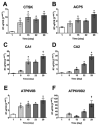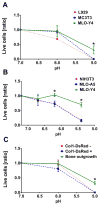Osteocytes Acidify Their Microenvironment in Response to PTHrP In Vitro and in Lactating Mice In Vivo
- PMID: 28470757
- PMCID: PMC5550338
- DOI: 10.1002/jbmr.3167
Osteocytes Acidify Their Microenvironment in Response to PTHrP In Vitro and in Lactating Mice In Vivo
Abstract
Osteocytes appear to mobilize calcium within minutes in response to PTH injections; we have previously shown that osteocytes remove their perilacunar matrix during lactation through activation of the PTH type 1 receptor. Mechanisms utilized by osteocytes to mobilize calcium are unknown but we hypothesized that the molecular components may be similar to those used by osteoclasts. Here we show, using IDG-SW3 cells that ATP6V0D2, an essential component of vacuolar ATPase in osteoclasts, and other genes associated with osteoclastic bone resorption, increase with osteoblast to osteocyte differentiation. Furthermore, PTHrP increases ATP6V0D2 expression and induces proton generation by primary osteocytes, which is blocked by bafilomycin, a vacuolar ATPase inhibitor. These in vitro proton measurements raised the question of osteocyte viability in an acidic environment. Interestingly, osteocytes, showed enhanced viability at pH as low as 5 compared to osteoblasts and fibroblasts in vitro. To study in vivo acidification by osteocytes, virgin and lactating CD1 mice on a low calcium diet were injected with the pH indicator dye, acridine orange, and their osteocyte lacuno-canalicular system imaged by confocal microscopy. Lower pH was observed in lactating compared to virgin animals. In addition, a novel transgenic mouse line with a topaz variant of green fluorescent protein (GFPtpz)-tagged collagen α2(I) chain was used. Instead of the expected reduction in GFP-fluorescence only in the perilacunar matrix, reduced fluorescence was observed in the entire bone matrix of lactating mice. Based on our experiments showing quenching of GFP in vitro, we propose that the observed reduction in GFP fluorescence in lactating mice is due to quenching of GFP by the acidic pH generated by osteocytes. Together these findings provide novel mechanistic insight into how osteocytes remove calcium from their perilacunar/pericanalicular matrices through active acidification of their microenvironment and show that osteocytes, like osteoclasts, are resistant to the negative effects of acid on viability. © 2017 American Society for Bone and Mineral Research.
Keywords: CELLS OF BONE; OSTEOCLASTS; OSTEOCYTES.
© 2017 American Society for Bone and Mineral Research.
Figures







References
-
- Prideaux M, Findlay DM, Atkins GJ. Curr Opin Pharmacol. Vol. 28. Elsevier Ltd; 2016. Osteocytes: The master cells in bone remodelling; pp. 24–30. [Internet] - PubMed
-
- Milovanovic P, Zimmermann EA, Hahn M, Djonic D, Pu K, Djuric M, Amling M, Division MS, Berkeley L, Road C, States U, Medicine F. Osteocytic Canalicular Networks: Morphological Implications for Altered Mechanosensitivity. ACS Nano. 2013;7(9):7542–51. - PubMed
-
- von Recklinghausen FV. Untersuchungen uber Rachitis und Osteomalacia. Jena: Gustav Fischer; 1910.
MeSH terms
Substances
Grants and funding
LinkOut - more resources
Full Text Sources
Other Literature Sources
Research Materials

